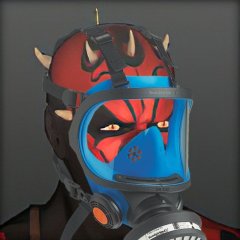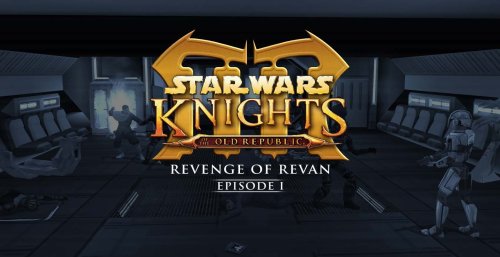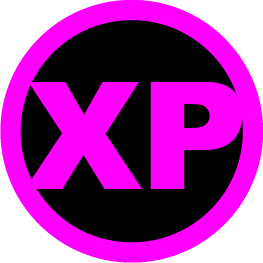-
Content Count
4,672 -
Joined
-
Last visited
-
Days Won
532
Content Type
Profiles
Forums
Blogs
Forum & Tracker Requests
Downloads
Gallery
Store
Calendar
Everything posted by DarthParametric
-

Kotor 1 - Stuck before Dantooine Star Map
DarthParametric replied to keegs's topic in Knights of the Old Republic General
Well if you saved right as the script fired then conceivably it stored the values of the scene having been triggered. Hopefully it should go without saying that in the future you should never attempt to save while in the middle of interacting with something. At least it wasn't my fault. Maybe I'll add a triggered autosave once the door has been unlocked before you get a chance to interact with it. -

Kotor 1 - Stuck before Dantooine Star Map
DarthParametric replied to keegs's topic in Knights of the Old Republic General
I'm still not sure how you manage to trigger this problem in the first place. Are you mashing on the left mouse button when opening it? The keyboard? Both? Maybe I'll try farming out the script to an invisible placeable and just have the door signal it. Although since I can't recreate the issue, I can't really test it. Anyway, I reset the door for you. The cutscene triggers fine on my end. Dantooine_Ruins_Star_Map_Door.7z -

Kotor 1 - Stuck before Dantooine Star Map
DarthParametric replied to keegs's topic in Knights of the Old Republic General
Only global changes belong in the Override folder. Module scripts get injected into the appropriate MOD file in the Modules folder. Can you attach a save file? The problem I had last time was that I couldn't reproduce the issue, so I was never entirely certain of the root cause. -

Kotor 1 - Stuck before Dantooine Star Map
DarthParametric replied to keegs's topic in Knights of the Old Republic General
What version? I have seen this bug once before, but I thought I had prevented it from occurring again. -
Since Tyvokka announced a while back on the DS Discord server that porting is now open season: the easiest solution is probably just to port Kyle's outfit from JKO/JKA. Might as well do the head too so you have the full experience. The textures would probably need a bit of a cleanup though, since they're presumably pretty low res. The other option might be if there's a newer rendition somewhere, like Battlefront or something.
-
-

Diversified Wounded Republic Soldiers on Taris
DarthParametric commented on DarthParametric's file in Mods
It's unlikely it has anything to do with OpenGL or GPU drivers. It's more likely to be something in the model that is not adhering exactly to the format when exported by KMax and compiled by MDLEdit/MDLOps. For whatever reason it doesn't trip up the Windows version. You'd probably need to attach a debugger and step through the game process to the point of the crash to find what the root cause is exactly. Btw, it would be useful if you could try the MDL/MDX/WOK sets for each room one at a time to see whether it's one or both of them that causes the crash. Might help narrow down the problem. K1CP replaces one of the models there to fix some visibility issues, so that would be the cause of that one presumably (since it was from me via KMax/MDLEdit again). I guess I'll need to re-export all the models for the next release. -

Diversified Wounded Republic Soldiers on Taris
DarthParametric commented on DarthParametric's file in Mods
-
The mobile versions are not an "officially" supported platform for the mod. The mod is developed for - and only tested on - the Windows version. An Android-specific version would require a dedicated contributor that could ascertain, create, and test the required changes. The likelihood of that happening seems low given that nobody (that I am aware of) has volunteered to do so during the better part of a decade that the mod has been around for.
- 289 comments
-
- 1
-

-
- patch
- compilation
-
(and 4 more)
Tagged with:
-
Because that's how the limited system they implemented works. Bodies are presets in appearance.2da, one model per armour class. Since the columns are hardcoded and we can't add more, the only way to get a unique body for a given armour is to create a disguise. And that's a pain in the ass if you want the character's head showing.
-
Extract into the game's Override folder. I was lazy and only did them as a Star Forge Robes/Revan's Robes replacement, so just add the item for those to your inventory via console command or KSE.
-
Yeah the door meshes have a white self-illum. But I think all doors probably have self-illum, since they aren't lightmapped. That's a bad combo with a white texture, although the degree to which it glows depends on the environment.
- 208 replies
-
- tslrcm 1.8.6
- tsl
-
(and 4 more)
Tagged with:
-
No. For starters, CM_Bright is blue. Could be the door has self-illum enabled though. What's the door type?
- 208 replies
-
- tslrcm 1.8.6
- tsl
-
(and 4 more)
Tagged with:
-
Hrm, can't see anything obvious loading up the layout with the edited models, so it seems like it's not the level models. Load up the module in Holocron Toolset and see if anything shows up there in the GIT editor. There's also the possibility of something being spawned in by script I guess.
- 208 replies
-
- tslrcm 1.8.6
- tsl
-
(and 4 more)
Tagged with:
-
Part of the level model presumably.
- 208 replies
-
- tslrcm 1.8.6
- tsl
-
(and 4 more)
Tagged with:
-
Remix uses a custom DXVK wrapper for DX9 to Vulkan. I would assume because it's open source and multiplatform. Not sure if it's possible to bridge that and get Remix to accept the Zink input. Might require custom code.
-
Interesting. Does it actually work with Remix though? Edit: Wait, that's DirectX 12. That's not going to work then I guess, since Remix needs 8/9. Oh well. Still might have other uses though.
-

wip 4x Upscale+ Character Textures & Model Fixes for KotOR & TSL
DarthParametric replied to redrob41's topic in Work In Progress
KSE got taken over by @Fair Strides many moons ago and I think someone else was helping with the last few versions? FS would have to chime in with the specifics. By the advent of v0.7, JdNoa was the primary author I believe. Fred Tetra contributed to changes in v0.6, FS and Varsity Puppet contributed to the changes in v0.7. -

wip 4x Upscale+ Character Textures & Model Fixes for KotOR & TSL
DarthParametric replied to redrob41's topic in Work In Progress
No? They were were always shit. The implementation is fundamentally broken and not recommended for use by anyone. Aside from that, basically other than TSLRCM/M4-78 and Effix's various mods, pretty much everything on there is stolen and uploaded without permission. HP is a relatively new tool. Aside from being multi-platform, it opens up some possibilities beyond what TSLPatcher can handle. You can hotlink to DS-hosted textures, although only as regular embeds in a post, not in the image carousel the mod pages have. I don't know whether mod page images have a maximum upload count. Probably a question that only @Tyvokka can answer fully. I would really question whether any mod actually needs 70-odd preview images though. Just attach a curated selection of a dozen or so to the mod page and link to an offsite gallery with the full showcase for those that want it. -

wip 4x Upscale+ Character Textures & Model Fixes for KotOR & TSL
DarthParametric replied to redrob41's topic in Work In Progress
I wasn't saying that you specifically should do it, just that Salk's request would make more sense if it harvested the heads and plonked them on the standard bodies. Someone else could do surgery. Left as-is they would be compatible with your textures with no further effort, but if you allow 3rd party mod reuse then they could probably stand to be remapped. You shouldn't be encouraging the use of Workshop mods. And no, loose textures aren't any more compatible with Workshop mods than other mods. Mac and Linux users can use the multi-platform HoloPatcher as a drop-in replacement for TSLPatcher, if it is required. -
- 289 comments
-
- patch
- compilation
-
(and 4 more)
Tagged with:
-

wip 4x Upscale+ Character Textures & Model Fixes for KotOR & TSL
DarthParametric replied to redrob41's topic in Work In Progress
If you're going to start chopping up body parts, you'd be better off just lopping off the lite heads and turning them into standalone heads and using them on the "full fat" bodies, since that seems to be the only thing you're actually after. -
- 31 comments
-
- k1cp
- community patch
-
(and 3 more)
Tagged with:







